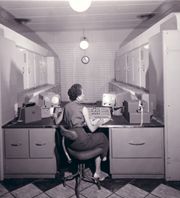
The Electronic Delay Storage Automatic Calculator (EDSAC) was an early British computer. Inspired by John von Neumann's seminal First Draft of a Report on the EDVAC, the machine was constructed by Maurice Wilkes and his team at the University of Cambridge Mathematical Laboratory in England. EDSAC was the second electronic digital stored-program computer to go into regular service.

The history of computing hardware covers the developments from early simple devices to aid calculation to modern day computers.

The Williams tube, or the Williams–Kilburn tube named after inventors Freddie Williams and Tom Kilburn, is an early form of computer memory. It was the first random-access digital storage device, and was used successfully in several early computers.
BINAC is an early electronic computer that was designed for Northrop Aircraft Company by the Eckert–Mauchly Computer Corporation (EMCC) in 1949. Eckert and Mauchly had started the design of EDVAC at the University of Pennsylvania, but chose to leave and start EMCC, the first computer company. BINAC was their first product, the first stored-program computer in the United States; BINAC is also sometimes claimed to be the world's first commercial digital computer even though it was limited in scope and never fully functional after delivery.
A stored-program computer is a computer that stores program instructions in electronically or optically accessible memory. This contrasts with systems that stored the program instructions with plugboards or similar mechanisms.
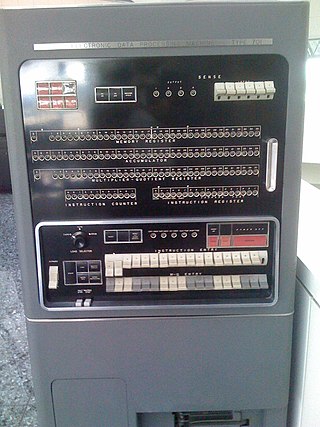
The IBM 701 Electronic Data Processing Machine, known as the Defense Calculator while in development, was IBM’s first commercial scientific computer and its first series production mainframe computer, which was announced to the public on May 21, 1952. It was designed and developed by Jerrier Haddad and Nathaniel Rochester and was based on the IAS machine at Princeton.
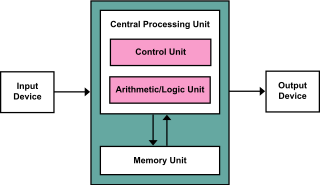
The von Neumann architecture—also known as the von Neumann model or Princeton architecture—is a computer architecture based on a 1945 description by John von Neumann, and by others, in the First Draft of a Report on the EDVAC. The document describes a design architecture for an electronic digital computer with these components:

The Manchester Baby, also called the Small-Scale Experimental Machine (SSEM), was the first electronic stored-program computer. It was built at the University of Manchester by Frederic C. Williams, Tom Kilburn, and Geoff Tootill, and ran its first program on 21 June 1948.

Tom Kilburn was an English mathematician and computer scientist. Over his 30-year career, he was involved in the development of five computers of great historical significance. With Freddie Williams he worked on the Williams–Kilburn tube and the world's first electronic stored-program computer, the Manchester Baby, while working at the University of Manchester. His work propelled Manchester and Britain into the forefront of the emerging field of computer science.
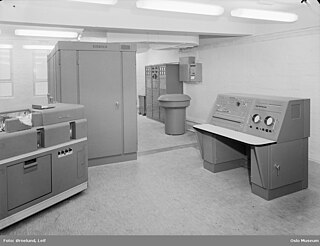
The DEUCE was one of the earliest British commercially available computers, built by English Electric from 1955. It was the production version of the Pilot ACE, itself a cut-down version of Alan Turing's ACE.
The Metrovick 950 was a transistorized computer, built from 1956 onwards by British company Metropolitan-Vickers, to the extent of six or seven machines, which were "used commercially within the company" or "mainly for internal use". The 950 appears to have been Metrovick's first and last commercial computer offering.

Pegasus was an early British vacuum-tube (valve) computer built by Ferranti, Ltd that pioneered design features to make life easier for both engineers and programmers. Originally it was named the Ferranti Package Computer as its hardware design followed that of the Elliott 401 with modular plug-in packages. Much of the development was the product of three men: W. S. (Bill) Elliott (hardware); Christopher Strachey (software) and Bernard Swann. It was Ferranti's most popular valve computer with 38 being sold. The first Pegasus was delivered in 1956 and the last was delivered in 1959. Ferranti received funding for the development from the National Research Development Corporation (NRDC).
UTEC was a computer built at the University of Toronto (UofT) in the early 1950s. It was the first computer in Canada, one of the first working computers in the world, although only built in a prototype form while awaiting funding for expansion into a full-scale version. This funding was eventually used to purchase a surplus Manchester Mark 1 from Ferranti in the UK instead, and UTEC quickly disappeared.

Mary Lee Berners-Lee was an English mathematician and computer scientist who worked in a team that developed programs in the Department of Computer Science, University of Manchester Mark 1, Ferranti Mark 1 and Mark 1 Star computers. She was the mother of Sir Tim Berners-Lee, the inventor of the World Wide Web, and Mike Berners-Lee, an English researcher and writer on greenhouse gases.
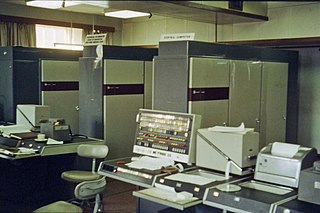
The Atlas Computer was one of the world's first supercomputers, in use from 1962 to 1972. Atlas' capacity promoted the saying that when it went offline, half of the United Kingdom's computer capacity was lost. It is notable for being the first machine with virtual memory using paging techniques; this approach quickly spread, and is now ubiquitous.

The Manchester computers were an innovative series of stored-program electronic computers developed during the 30-year period between 1947 and 1977 by a small team at the University of Manchester, under the leadership of Tom Kilburn. They included the world's first stored-program computer, the world's first transistorised computer, and what was the world's fastest computer at the time of its inauguration in 1962.

The Manchester Mark 1 was one of the earliest stored-program computers, developed at the Victoria University of Manchester, England from the Manchester Baby. Work began in August 1948, and the first version was operational by April 1949; a program written to search for Mersenne primes ran error-free for nine hours on the night of 16/17 June 1949.
Ferranti's Sirius was a small computer released in 1961. Designed to be used in smaller offices without a dedicated programming staff, the Sirius used decimal arithmetic instead of binary, supported Autocode to ease programming, was designed to fit behind a standard office desk, and ran on UK standard mains electricity with no need for cooling. It was also fairly slow, with instruction speeds around 4,000 operations per second, and had limited main memory based on delay lines, but as Ferranti pointed out, its price/performance ratio was difficult to beat.
Beatrice Helen Worsley was the first female Canadian computer scientist. She received her Ph.D. degree from the University of Cambridge with Maurice Wilkes as adviser, the first Ph.D. granted in what would today be known as computer science. She wrote the first program to run on EDSAC, co-wrote the first compiler for Toronto's Ferranti Mark 1, wrote numerous papers in computer science, and taught computers and engineering at Queen's University and the University of Toronto for over 20 years before her death at the age of 50.
Margery Audrey Bates (Clayton Wallis) (1928-2014) was a British-American computer programmer who, in 1948, wrote the earliest program for lambda calculus calculations on the Manchester Mark I computer.
